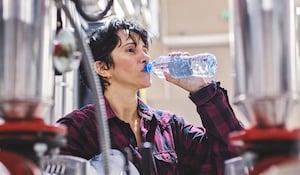After a long hot summer, cooler temperatures may finally be right around the corner. Of course, we know that in some areas of the Midwest United States it can still get unbearably hot in the fall. The reality is even worse for those working outside in warmer states. Sun exposure and physical labor can create heat safety concerns well into November. How can managers ensure the health and well-being of employees working outside?
Here are a few of the ways worksite managers can prevent temperature-related injuries like heat stroke:
 Planning: The most important step in avoiding problems like heat stroke is planning. Humans have been overheating in hot temperatures for as long as we have existed. If you know your people are working hard under the sun, why not take steps to keep them safe in advance? Make a heat safety review part of your initial site analysis. Perhaps most importantly, realize that your employees will need somewhere to cool down. If you cannot immediately identify the cooling locations, it may be time to research mobile offices for sale.
Planning: The most important step in avoiding problems like heat stroke is planning. Humans have been overheating in hot temperatures for as long as we have existed. If you know your people are working hard under the sun, why not take steps to keep them safe in advance? Make a heat safety review part of your initial site analysis. Perhaps most importantly, realize that your employees will need somewhere to cool down. If you cannot immediately identify the cooling locations, it may be time to research mobile offices for sale.- Prepare a cooling station. One of the most effective methods for preventing heat-related illnesses is cooling stations. During the initial site analysis, set aside space for temperature-controlled mobile offices. The mobile offices can be available in a variety of sizes and configurations, so you can find one that works for you. For smaller worksites, a 20' mobile office may be large enough. Larger companies may want to consider multiple offices or upgrading to a 40' mobile office. For worksites in need of both storage and office space, many portable offices also come with storage space. Cooling stations provide employees with a convenient onsite location to avoid the heat.
 Provide for hydration needs. Everybody knows by now that staying hydrated is an essential part of beating the heat. But the logistics of keeping employees hydrated on an outdoors worksite can be tricky. If there are no water fountains nearby, employees may have to wander when thirsty. Water stored in a vehicle during hot weather will, of course, absorb the heat. Long-term, drinking water in heated plastic can be risky as the plastic can leak chemicals. In the short-term, drinking hot water can actually raise your body temperature. For best results, store water bottles in ice chests or inside temperature-controlled portable offices.
Provide for hydration needs. Everybody knows by now that staying hydrated is an essential part of beating the heat. But the logistics of keeping employees hydrated on an outdoors worksite can be tricky. If there are no water fountains nearby, employees may have to wander when thirsty. Water stored in a vehicle during hot weather will, of course, absorb the heat. Long-term, drinking water in heated plastic can be risky as the plastic can leak chemicals. In the short-term, drinking hot water can actually raise your body temperature. For best results, store water bottles in ice chests or inside temperature-controlled portable offices.- Designate a foreman or safety coordinator to track heat-related issues. Many leaders find that they need to delegate a task to a specific person to get it managed correctly. It can also be a mistake to depend on each employee to identify when they need to cool down. According to the Mayo Clinic, one of the signs of heatstroke is "altered mental state or behavior." That means a person who needs help may not be capable of seeking assistance. Designated staff can also help spread information about heat safety. Using a central contact for employee feedback regarding heat conditions may improve efficiency.
- Make sure employees recognize the signs of heat stress. As mentioned above, one of the signs of heatstroke is confusion. Confusion around dangerous machinery is life-threatening for everyone on the job site. That means everyone has to be trained to recognize the symptoms of heat-related illnesses. Minutes matter in addressing heatstroke, but seconds matter in accidents. Other risks of heat stress include sunburn, heat cramps, and heat exhaustion. According to the Mayo Clinic, common visible signs of heat-related problems include changes in sweating, muscle cramps, headache, and nausea/dizziness. Posting flyers and hosting short training sessions can ensure your employees can act fast when needed.
- Include cooling periods during the workday. When you are under pressure and facing deadlines, time management is vital. Like all elements of worker safety, preventing heat illnesses takes a firm commitment. Managers and employees should set regular schedules for cooling breaks. Employees can rotate through the cooling centers, or schedule production breaks. While resting in the shade can provide some relief from the sun, humidity can be another factor. Humid conditions can prevent sweat evaporation. Without that process, humans lose our primary temperature control mechanism. Designated cooling centers such as modular offices can provide the perfect heat breaks.
No matter what kind of work you do outside, thinking through heat safety is necessary. If you live in a warmer climate, avoiding heat illnesses can require a significant investment of time and money. Keeping employees safe is an essential part of any successful enterprise. Employees should be encouraged to hydrate while working. Safety permitting, workers should wear flowing, lightweight clothing. Whenever possible, schedule the most grueling tasks for early mornings.
The reality is, the most important things you can do are prepare and think ahead. Leadership often means anticipating conditions before they affect your business. Get a quote from SiteBox Storage to begin making a plans for the heat.
